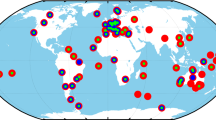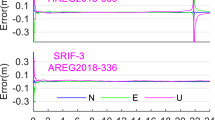Abstract
Observation data sets from three different periods and 23 International GNSS Service (IGS) stations spread over the world were processed in static mode using four online free precise point positioning (PPP) services: Automatic Precise Positioning Service (APPS), GPS Analysis and Positioning Software, Canadian Spatial Reference System precise point positioning service, and Magic-PPP. The estimated positions of the 23 IGS stations were compared with the published values. The estimated zenith tropospheric delays (ZTDs) at these stations were compared with the corresponding IGS troposphere products published on the IGS Web site. Furthermore, in order to analyze PPP precision for short observation periods, GPS observation data sets with a sampling rate of 1 s collected by one CORS station were also processed by the four online PPP services. Calculation shows that the precision of daily solutions for north and east (N/E) components estimated by the four online PPP services can reach millimeter level, the precision of ellipsoid elevation (H) can reach 1–2 cm, and precision of ZTDs estimation results is approximately 1–2 cm. Compared with the corresponding values published on the IGS Web site, the precision of ZTDs estimated by APPS is higher than those estimated by the other three PPP online services; the differences between ZTDs by APPS and IGS values are mostly within ±1 cm. For PPP with short observation periods, the precision of N/E components within 2, 1, and 0.5 h observation periods can reach about 2–3, 2–7, and 3–8 cm, respectively, while the precision of H components is about 3–5, 5–12, and 10–18 cm, respectively.






Similar content being viewed by others
References
Altamimi Z, Collilieux X, Métivier L (2011) ITRF2008: an improved solution of the international terrestrial reference frame. J Geodesy 85(8):457–473
Bertiger W, Desai SD, Haines B et al (2010) Single receiver phase ambiguity resolution with GPS data. J Geodesy 84(5):327–337
Dow JM, Neilan RE, Rizos C (2009) The International GNSS Service in a changing landscape of global navigation satellite systems. J Geodesy 83(3–4):191–198
Gao P, Guo F, Lv C, Tang L (2011) Precision analysis and comparison of on-line precise point positioning services. Glob Position Syst 3:21–24
Ghoddousi-Fard R, Dare P (2006) Online GPS processing services: an initial study. GPS Solut 10(1):12–20
Grinter T, Roberts C (2011) Precise point positioning: where are we now? International Global Navigation Satellite Systems Society IGNSS symposium 2011, Sydney, NSW, Australia, 15–17 November
Grinter T, Roberts C (2013) Real time precise point positioning: are we there yet? International Global Navigation Satellite Systems Society IGNSS symposium outrigger, Gold Coast, QLD, Australia, 16–18 July
Kouba J (2009) A guide to using International GNSS Service (IGS) products. http://igscb.jpl.nasa.gov/components/usage.html
Kouba J, Heroux P (2001) Precise point positioning using IGS orbit and clock products. GPS Solut 5(2):12–28
Leandro RF, Santos MC, Langley RB (2007) GAPS: the GPS analysis and positioning software—a brief overview. In: Proceedings of the ION GNSS 2007, Institute of Navigation, 25–28, September, Fort Worth, TX, pp 1807–1811
Martín A, Anquela AB, Capilla R, BernéJ L (2011) PPP technique analysis based on time convergence, repeatability, IGS products, different software processing, and GPS + GLONASS constellation. J Surv Eng 137(3):99–108
Xu YB (2011) The precision comparison and analysis of online PPP software. Geomat Spat Inf Technol 34(4):167–169
Zumberge J, Heflin M, Jefferson D, Watkins M, Webb FH (1997) Precise point positioning for the efficient and robust analysis of GPS data from large networks. J Geophys Res 102(B3):5005–5017
Acknowledgments
This research is supported by the National Natural Science Foundation of China (41301509) and Shandong Provincial Department of Housing and Urban Rural Construction Technology Project Plan (KY026). The author greatly appreciates the efforts of the IGS, the analysis and data Center, and the tracking stations managers for generating high-quality data and products, and making them available to the GNSS community in a timely and reliable manner. The author also thanks the online PPP software service systems and their valuable comments on how to use the online PPP services. The author also greatly appreciates the two anonymous reviewers for their comments on this manuscript.
Author information
Authors and Affiliations
Corresponding author
Rights and permissions
About this article
Cite this article
Guo, Q. Precision comparison and analysis of four online free PPP services in static positioning and tropospheric delay estimation. GPS Solut 19, 537–544 (2015). https://doi.org/10.1007/s10291-014-0413-5
Received:
Accepted:
Published:
Issue Date:
DOI: https://doi.org/10.1007/s10291-014-0413-5




